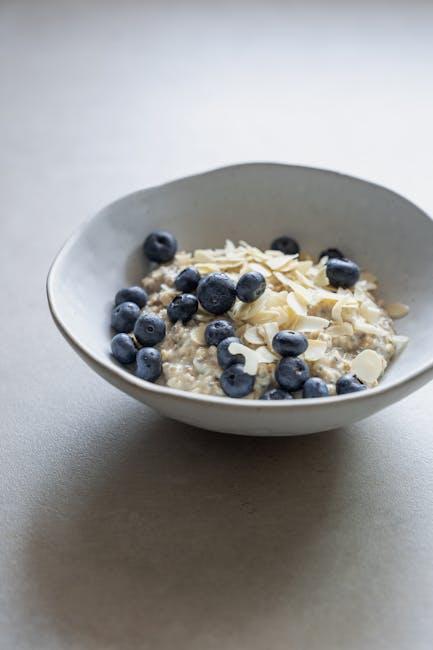In the ever-evolving world of nutrition, diets often emerge promising not only better health but a clearer understanding of how food interacts with our bodies. Among these, the GAPS Diet and the Paleo Diet stand out as influential approaches, each rooted in distinct philosophies and aimed at healing from within. While they share some similarities, their core principles and applications reveal key differences that can influence which path might be best suited for individual needs. This article delves into the defining elements of the GAPS Diet and the Paleo Diet, unpacking their unique qualities to help you navigate the choice between these two popular dietary frameworks.
Table of Contents
- Understanding the Foundations of GAPS and Paleo Diets
- Comparing Nutritional Focus and Food Restrictions
- Digestive Health Approaches and Gut Healing Strategies
- Assessing Lifestyle Compatibility and Long-Term Sustainability
- Tailoring Your Choice Based on Health Goals and Preferences
- Q&A
- Future Outlook

Understanding the Foundations of GAPS and Paleo Diets
The GAPS (Gut and Psychology Syndrome) and Paleo diets both emphasize a return to natural, whole foods, yet their foundations stem from different health philosophies. The GAPS diet is primarily designed to heal digestive disorders and neurological conditions by focusing on gut health. It leans heavily on fermented foods, bone broths, and nutrient-dense soups believed to restore the gut lining and rebalance intestinal flora. The GAPS approach incorporates a staged introduction of foods, starting with easily digestible items and gradually expanding the diet as healing progresses.
Conversely, the Paleo diet traces its roots to evolutionary biology, advocating the foods presumed to be eaten by our Paleolithic ancestors. This diet emphasizes high protein, healthy fats, and low carbohydrate intake by excluding grains, legumes, and processed foods. While both diets avoid processed foods and refined sugars, Paleo puts a stronger focus on macronutrient balance and ancestral lifestyle rather than targeted healing. Below is a comparison to illustrate their core differences:
| Aspect | GAPS Diet | Paleo Diet |
|---|---|---|
| Primary Goal | Gut healing & neurological health | Evolutionary nutrition & metabolic health |
| Food Introduction | Gradual, staged process | Broader immediate food variety |
| Fermented Foods | Essential for gut flora restoration | Optional but encouraged |
| Allowed Proteins | Meat, fish, homemade broths | Grass-fed meats, wild fish |
| Restricted Foods | Starches, sugars, processed foods initially | Grains, legumes, dairy |

Comparing Nutritional Focus and Food Restrictions
When examining the nutritional focus of these two diets, the GAPS Diet centers primarily on healing the gut and restoring digestive health. Its emphasis lies in nutrient-dense, homemade broths, fermented foods, and high-quality fats that support gut flora balance and reduce inflammation. In contrast, the Paleo Diet targets a broader approach to mimic the eating patterns of early humans, prioritizing whole, unprocessed foods such as lean meats, vegetables, fruits, nuts, and seeds. While both diets eliminate processed sugar and refined grains, the GAPS system is more restrictive, especially in its early stages, as it avoids starchy vegetables and high-sugar fruits to minimize digestive strain.
In terms of food restrictions, the GAPS Diet excludes all grains, processed foods, sugars (except honey in limited amounts), and pasteurized dairy initially, with reintroductions happening cautiously over time. The Paleo Diet, meanwhile, excludes grains, legumes, dairy (mostly), refined sugars, and industrial oils but allows for a wider variety of fruits and starchy vegetables. The table below highlights some key exclusions and focus areas:
| Food Category | GAPS Diet | Paleo Diet |
|---|---|---|
| Grains | Strictly avoided | Strictly avoided |
| Dairy | Fermented allowed, others avoided initially | Mostly avoided, some Paleo allow raw dairy |
| Fruits | Limited, low-sugar varieties first | Wide variety, no restriction |
| Vegetables | Limited starchy, nutrient-dense emphasized | All vegetables encouraged, including starchy |
| Sugars | Only honey in moderation | Natural sweeteners like honey and maple allowed |

Digestive Health Approaches and Gut Healing Strategies
When it comes to nurturing digestive health, both the GAPS and Paleo diets offer unique frameworks centered around healing the gut, but their approaches diverge significantly in methodology and focus. The GAPS diet emphasizes restoring the digestive lining and rebalancing gut flora by removing difficult-to-digest carbohydrates and introducing homemade broths, fermented foods, and probiotic-rich options. It aims to soothe inflammation and eradicate harmful pathogens, creating an internal environment conducive to optimal nutrient absorption. Key components include:
- Bone broths for collagen and healing compounds
- Fermented vegetables for natural probiotics
- Elimination of starch and sugar to starve detrimental bacteria
Conversely, the Paleo diet prioritizes whole, unprocessed foods resembling those of hunter-gatherer ancestors, supporting gut health through nutrient density and the exclusion of grains, legumes, and dairy that some individuals find irritating to digestion. While not as strict in gut-healing protocols as GAPS, Paleo’s high intake of anti-inflammatory fats and fiber helps maintain gut integrity and microbial diversity. Key Paleo principles beneficial for digestion include:
- Grass-fed meats rich in omega-3 fatty acids
- Fresh vegetables and fruits loaded with fiber and antioxidants
- Nuts and seeds providing essential micronutrients
| Aspect | GAPS Diet | Paleo Diet |
|---|---|---|
| Primary Goal | Gut lining repair & microbiome balance | Whole food nutrition & inflammation reduction |
| Allowed Foods | Homemade broths, fermented foods, limited carbs | Meats, vegetables, nuts, fruits; no grains or legumes |
| Probiotics | Central element via fermented foods | Beneficial but less emphasized |
| Carbohydrate Intake | Strictly limited initially | Moderate, from natural sources |

Assessing Lifestyle Compatibility and Long-Term Sustainability
When deciding between these two dietary approaches, it’s essential to consider how each fits into your current lifestyle and your ability to maintain it over the long term. The Paleo diet offers flexibility with a broad range of whole foods, making it easier to adapt for many social settings and family meals. Its focus on lean meats, vegetables, fruits, nuts, and seeds aligns well with common healthy eating practices, which can support sustainable habits without causing significant disruptions to daily routines.
In contrast, the GAPS diet is more restrictive and therapeutic, often requiring meticulous planning, especially during the initial stages. The protocol emphasizes gut healing through specific food preparations and gradual introductions, which may demand more time, effort, and dedication. This can pose challenges in social situations, travel, or dining out. Below is a quick comparison to help visualize compatibility factors:
| Factor | Paleo Diet | GAPS Diet |
|---|---|---|
| Social Flexibility | Moderate (can accommodate social eating) | Low (strict phases limit options) |
| Meal Preparation Time | Moderate | High (requires specific methods) |
| Long-Term Maintenance | Relatively Easy | Challenging (especially early on) |
| Focus | Overall health & wellness | Gut healing & symptom relief |
- Consider your daily routine: Time constraints and social habits.
- Evaluate goals: General wellness versus targeted gut health restoration.
- Plan for flexibility: Ability to adapt during holidays, dining out, or unexpected changes.

Tailoring Your Choice Based on Health Goals and Preferences
Both the GAPS and Paleo diets offer unique pathways to improved health, but your personal objectives and preferences will ultimately guide the best fit. If gut healing and addressing neurological or autoimmune issues are your priorities, the GAPS diet—with its phased approach focusing on fermented foods, bone broths, and carefully reintroducing foods—could be the ideal choice. Conversely, if your aim is to embrace a broader, whole-foods lifestyle that can support weight loss, energy, and reduced inflammation, the Paleo diet offers a more flexible regimen that emphasizes lean proteins, nuts, and vegetables without strict stages.
To help clarify your decision, consider the factors below:
- Health Goals: Targeted healing vs. general wellness
- Dietary Restrictions: Willingness to commit to strict phases or preference for variety
- Food Preferences: Tolerance for fermented and soaked foods (GAPS) vs. unrestricted consumption of natural carbs like sweet potatoes and fruits (Paleo)
- Lifestyle Compatibility: Time-intensive food prep vs. easier meal options
| Factor | GAPS Diet | Paleo Diet |
|---|---|---|
| Primary Focus | Gut healing and neurological support | Inflammation reduction and ancestral eating |
| Meal Planning | Phased, restrictive approach | Flexible, whole-food based |
| Common Foods | Fermented veggies, bone broth, eggs | Lean meats, nuts, fruits, veggies |
| Adaptability | Slower transitions | More varied and lenient |
Q&A
Q&A: GAPS Diet vs Paleo Diet – Key Differences Uncovered
Q1: What do the acronyms GAPS and Paleo stand for?
A1: GAPS stands for Gut and Psychology Syndrome, a diet created by Dr. Natasha Campbell-McBride focusing on gut healing. The Paleo Diet, short for Paleolithic Diet, mimics the eating habits of our ancient hunter-gatherer ancestors, emphasizing whole, unprocessed foods.
Q2: What is the primary goal of the GAPS Diet?
A2: The GAPS Diet aims to restore gut health by healing the intestinal lining, reducing inflammation, and rebalancing gut flora to improve both digestive and neurological symptoms.
Q3: And the Paleo Diet’s main focus?
A3: The Paleo Diet’s goal is to promote overall wellness and metabolic health by consuming foods presumed to be available in the Paleolithic era, avoiding modern processed foods, grains, and dairy.
Q4: How do their food restrictions differ?
A4: GAPS is more restrictive initially, cutting out all grains, sugars, starches, processed foods, and most dairy to allow gut healing. Paleo generally excludes grains, legumes, refined sugar, and dairy but is more flexible with fruits, nuts, and starchy vegetables.
Q5: Is the GAPS Diet suitable for everyone?
A5: GAPS is often tailored for individuals with gut-related issues, autoimmune conditions, and neurological disorders; it can be challenging and is best followed under professional guidance. Paleo is more widely adopted as a general clean-eating lifestyle for health enthusiasts.
Q6: How do both diets handle dairy?
A6: GAPS diet allows fermented dairy like homemade yogurt and kefir, but only after an introductory phase, to aid digestion. Paleo generally excludes dairy, although some versions permit grass-fed butter or fermented dairy for those who tolerate it.
Q7: What about the approach to carbohydrates?
A7: GAPS gradually reintroduces carbs, focusing on nutrient-dense vegetables and homemade broths that soothe the gut. Paleo encourages a moderate intake of carbs from fruits, nuts, and tubers but avoids grains and processed carbs entirely.
Q8: Can both diets be adapted for vegetarians or vegans?
A8: Both diets emphasize animal-based foods and can be difficult to adapt strictly for vegetarians or vegans due to their reliance on meat, fish, and animal fats for nutrient density, especially in GAPS for gut healing.
Q9: Which diet is backed by more scientific research?
A9: Paleo has garnered more mainstream research related to metabolic health and chronic disease prevention. GAPS, being more specialized and newer, has less broad scientific validation but anecdotal support in communities dealing with gut and neurological issues.
Q10: How do these diets impact lifestyle and meal planning?
A10: GAPS requires meticulous meal prep, often homemade broths and fermented foods, and a staged approach to food introduction. Paleo encourages simplicity with whole foods but can be more flexible and easier for day-to-day living.
Summary: While both GAPS and Paleo diets share an aversion to processed foods and grains, GAPS is a targeted therapeutic plan for gut healing, requiring strict phases and restrictions, whereas Paleo offers a broader evolutionary-inspired eating template aimed at long-term health and wellness. Choosing between them depends on your health goals, lifestyle, and personal needs.
Future Outlook
In the end, both the GAPS and Paleo diets invite us to rethink the way we nourish our bodies, each offering a unique approach rooted in ancestral wisdom yet tailored to distinct health goals. While the GAPS diet zeroes in on gut healing through staged reintroduction and nutrient-dense foods, the Paleo diet casts a wider net, emphasizing whole, unprocessed ingredients that mirror our evolutionary past. Choosing between them ultimately comes down to personal needs, lifestyle, and how your body responds. Whether you find yourself drawn to the therapeutic steps of GAPS or the broad simplicity of Paleo, both paths serve as valuable blueprints for reconnecting with food that supports our well-being in a modern world.














Leave feedback about this